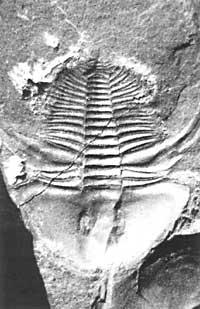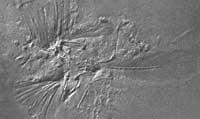Is man the goal of evolution?
1994/11/01 Martinez Lizarduikoa, Alfontso Iturria: Elhuyar aldizkaria
In British Columbia, in the Canadian mountain range, in 1909, very curious fossils of the Cambrian era were discovered (570-500 million years ago). These fossils tell us about the animals that lived in the sea in those distant times (550 million years ago). They are the only witnesses we have to know what happened in the first epoch of Cambodia, and very important, especially for two reasons.
On the one hand, because they are the ancestors of all the animals that would be created with a later evolution. On the other hand, these fossils are of carnal origin (still in evolution, the thorns and shells were not formed) and from this point of view they can be seen as miracles of paleontology. Remember that almost all fossil record information has been based on hard parts of animals, as it is very difficult for others (invertebrates) to carry out a fossilization process.
At first nobody thought about the revolution in those fossils, but after that time, and after a deep study, there is no doubt: Since Darwin created evolutionary theory, it seems to be the most important paleontological discovery.
The fossil quarry of Burgess Shale (so called), in Cambodia, tells us that in the terrestrial seas there were 40 phylas (basic designs of life that would come later). Among these designs were the 20 phyls that we know today, but also another twenty for totally unknown paleontologists and that later hid in the evolution of life. We have been able to learn these special designs, which have disappeared from our world, in the prodigious fossils of Burgess Shale, as well as their completely new features, which we do not find in today's life.
And besides being very curious, we have surprisingly realized that these special animals were not better adapted to stay alive in front of those who survive today. Studied in their environment, paleontologists consider that any of them could advance in the evolutionary tree of life, surviving and evolving to date. According to the prestigious paleontologist Stephen Gould, “If we are back in the Cantabrian period and evolution had the opportunity to repeat its path, probably the evolutionary paths that have existed so far would not be repeated. In our world there would probably be no cockroaches, mosquitoes or flies, bees and beauty of the flowers we know today. We could see another totally different living planet.”
This paleontological discovery generates another revolutionary idea. If evolution repeats itself, it surely would not be the human beings we know today. If intelligence is created, it would emerge from another basic structure (phyla), totally different from ours. Therefore, we have come to the most revolutionary side of Darwin's theory. Evolution has no obligatory objective.
Evolution, depending on the physical-chemical-geological-ecological state, gives a series of answers that will try to follow all possible paths in evolution. The possibilities that occur in different places and situations of the universe are infinite (according to astrophysics and current cosmology), but for us the most disturbing thing of the moment is to know that in our beloved house (Lur) there can also exist different highways for life and mind, and if we are born it has been by contingency. Also, if the film is repeated we probably wouldn't appear here again.

Gai honi buruzko eduki gehiago
Elhuyarrek garatutako teknologia




